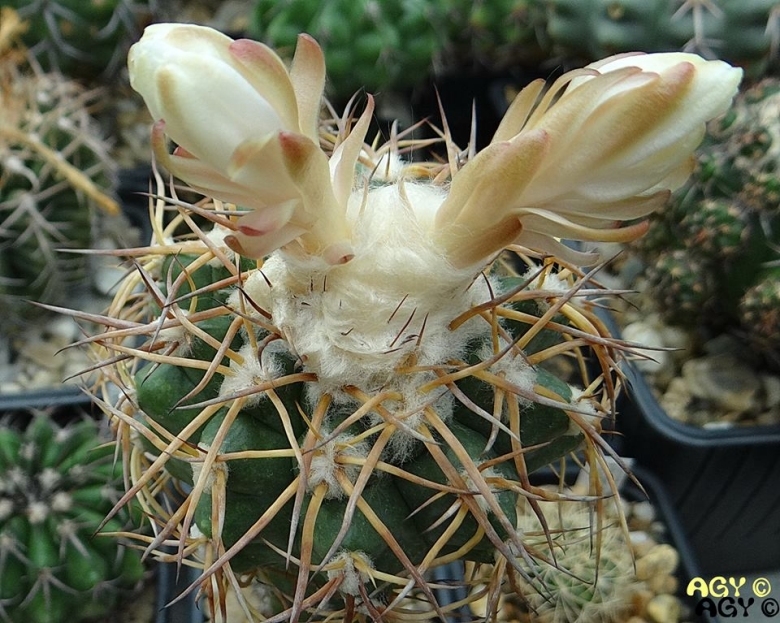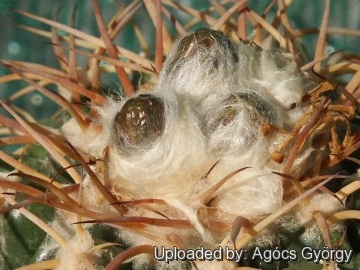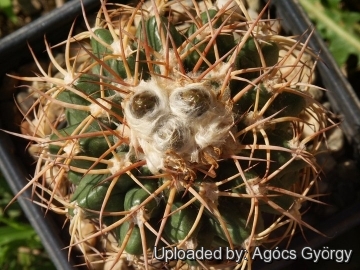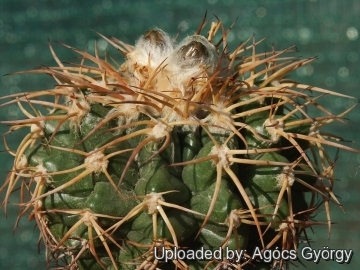Accepted Scientific Name: Discocactus bahiensis Britton & Rose
Cactaceae (Britton & Rose) 3: 220 1922 Britton & Rose

Echinocactus bahiensis (Discocactus bahiensis) Photo by: Agócs György
Origin and Habitat: Discocactus bahiensisSN|31323]]SN|31323]] is endemic to Brazil. It grows in the Rio São Francisco drainage of northern Bahia and Pernambuco; in Ceará it is found along the drainage of the river Jaguaribe, and in northwestern Piauí near the Rio Canindé. The species has a very patchy distribution; and its area of occupancy is less than 500 km2. Some subpopulations are extensive, but most of them are small and consist of less than 500 mature individuals. About 30 percent of the population has already disappeared due to habitat loss, in particular related to the construction of the Sobradinho dam and roads, as well as urbanization.
Altitude range: It occurs at altitudes between 380 and 650 metres above sea level.
Habitat and Ecology: This northern caatinga element grows on exposed, gravelly river terraces amongst limestone or iron-stained quartzite as well as in seasonally inundated river floodplains within the caatinga. Its generation length is 15 to 20 years. This species is listed as Vulnerable based on an estimated past population decline of greater than 30% as a result of the ongoing decline in area and quality of the species habitat. Some parts suffer the impact of urbanization, agriculture, construction activities, and quarrying of limestone. The species is also subject to collection. of seeds and entire plants by cacti collectors, and the stems are locally harvested for making candy.
Synonyms:
See all synonyms of Discocactus bahiensis
back
Accepted name in llifle Database:Discocactus bahiensis Britton & RoseCactaceae (Britton & Rose) 3: 220 1922Synonymy: 7
back
Description: Discocactus bahiensisSN|1430]]SN|31323]] is a small, flattened globose to globose species to 8 cm in diameter. At first plants are solitary, with heavy spination and produces a small cephalium, a structure formed by trichomes (woolly hairs) from which emerge the tubular, yellowish-white, sweetly scented flowers. Two subspecies are recognized, the nominate form and subs. subviridigriseus, they differ in shape and length of the spines. Both subspecies may produce several offsets after making a cephalium. Discocactus bahiensisSN|31323]]SN|31323]] is related and sometimes synonymized with to Discocactus placentiformisSN|31323]]SN|1430]].
Derivation of specific name: Bahiensis: for the occurrence in the state of Bahia (Brazil).
Stem: About 6-8 cm in diameter, somewhat flattened, dark or bluish green.
Ribs: About 10-15, but nearly hidden under the mass of spines acute and slightly tuberculate.
Areoles: Oval and woolly. Number of areoles per rib about 5 on plants with a cephalium.
Spines: Conspicuous, stout, 7 to 9, slightly flattened, somewhat curved backward, amber-, rose- to horn-coloured, 1.5 to 3(3.5) cm long.
Cephalium: Prominent, made up of a mass of white to cream/brown wool and a few short bristles.
Flowers: 4 to 5 cm long funnelform with a slender tube; perianth-segments oblong, white, tinged with yellow.
Fruit: A small, white to rose-red, naked berry.
Seeds: Globular, tuberculate.
Subspecies, varieties, forms and cultivars of plants belonging to the Discocactus bahiensis group
 Discocactus bahiensis Britton & Rose: (subsp. bahiensis) has flattened globose to globose stems to 8 cm in diameter with 10-15 ribs. Spines 7-9, stout, amber-rose to horn-coloured to 3(3.5) cm long. Distribution: Brazil (Bahia, Ceará, Pernambuco, Piauí)
Discocactus bahiensis Britton & Rose: (subsp. bahiensis) has flattened globose to globose stems to 8 cm in diameter with 10-15 ribs. Spines 7-9, stout, amber-rose to horn-coloured to 3(3.5) cm long. Distribution: Brazil (Bahia, Ceará, Pernambuco, Piauí) Discocactus bahiensis subs. subviridigriseus (Buining & Bredero) P.J.Braun & Esteves: is a larger plant with 13—15 ribs, rather than the usual 10 ribs of subspecies bahiensis. Distribution: Bahia.
Discocactus bahiensis subs. subviridigriseus (Buining & Bredero) P.J.Braun & Esteves: is a larger plant with 13—15 ribs, rather than the usual 10 ribs of subspecies bahiensis. Distribution: Bahia.
Bibliography: Major references and further lectures
1) Edward Anderson “The Cactus family” Timber Press, Incorporated, 2001
2) James Cullen, Sabina G. Knees, H. Suzanne Cubey "The European Garden Flora Flowering Plants: A Manual for the Identification of Plants Cultivated in Europe, Both Out-of-Doors and Under Glass" Cambridge University Press, 11/Aug/2011
3) David R Hunt; Nigel P Taylor; Graham Charles; International Cactaceae Systematics Group. "The New Cactus Lexicon" dh books, 2006
4) N. L. Britton, J. N. Rose “The Cactaceae. Descriptions and Illustrations of Plants of the Cactus Family.” Volume 3, The Carnegie Institution of Washington, Washington 1922
5) Machado, M., Braun, P., Taylor, N.P. & Zappi, D. 2013. Discocactus bahiensis. The IUCN Red List of Threatened Species. Version 2015.2. <www.iucnredlist.org>. Downloaded on 26 June 2015.
6) Urs Eggli, Leonard E. Newton “Etymological Dictionary of Succulent Plant Names” Springer Science & Business Media, 29 June 2013
7) Taylor, N. & Zappi, D. 2004. “Cacti of Eastern Brazil.” Royal Botanic Gardens, Kew.
8) Taylor, N.; Santos, M.R.; Zappi, D. "Discocactus in Lista de Espécies da Flora do Brasil." Jardim Botânico do Rio de Janeiro. Disponível em: <http://reflora.jbrj.gov.br/jabot/floradobrasil/FB1483>. Acesso em: 26 Jun. 2015
9) Andreas Hofacker “Der Formenkreis um Discocactus bahiensis Britton & Rose in Bahia, Brasilien.” In: Kakteen und andere Sukkulenten. 53(8): 200–205 2002.
10) Buining & Brederoo .In: Kakteen und andere Sukkulenten. 1979 page 190.
 Echinocactus bahiensis (Discocactus bahiensis) Photo by: Agócs György
Echinocactus bahiensis (Discocactus bahiensis) Photo by: Agócs György Echinocactus bahiensis (Discocactus bahiensis) Photo by: Agócs György
Echinocactus bahiensis (Discocactus bahiensis) Photo by: Agócs György Echinocactus bahiensis (Discocactus bahiensis) Photo by: Agócs György
Echinocactus bahiensis (Discocactus bahiensis) Photo by: Agócs György Echinocactus bahiensis (Discocactus bahiensis) Photo by: Agócs György
Echinocactus bahiensis (Discocactus bahiensis) Photo by: Agócs GyörgyCultivation and Propagation: Collectors consider this cactus genus from South America to be rarities as they are not the easiest plant to keep happy. it is rather difficult to grow and frost tender, should be kept at above 15° C if grown on its own roots (8°C if grafted) need full sun or afternoon shade. Young seedlings are generally grafted because they are slow growing and very rot prone when kept on their own roots and though they can’t endure long stretches of total dryness, too much water will rot them, as their weak root systems tend to be inefficient at sucking up water from wet soil. They generally resent being repotted and can take a long time to establish.
Propagation: Seed. Young seedlings are often grafted on a low stock to keep the plant in a good shape.














